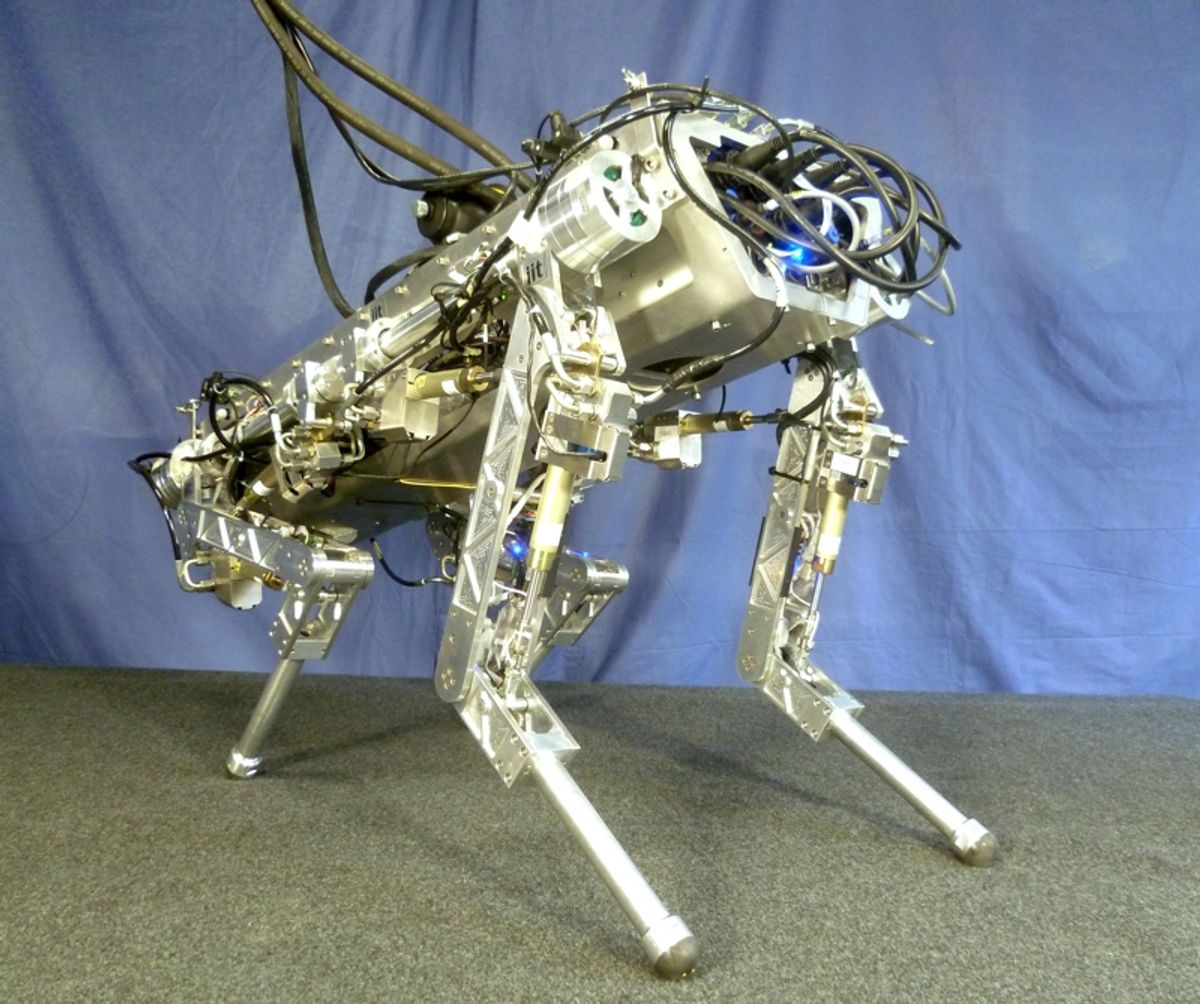It's not quite an invasion, but in recent years we've seen a small parade of quadruped robots strutting out of labs around the world. In the United States, Boston Dynamics has introduced its now-famous BigDog and, more recently, a bigger bot named AlphaDog. Early this year, we wrote about FROG, a prototype built in China, and just a few weeks ago we described the SQ1 robot, a South Korean project.
Now it's time to unveil the latest addition to this pack: HyQ is a robot developed at the Istituto Italiano di Tecnologia (IIT), in Genoa. The machine, built by a team led by Professor Darwin Caldwell, is a hydraulic quadruped (hy-q, get it?) designed to perform highly dynamic tasks such as running and jumping.
Legged locomotion remains one of the biggest challenges in robotics, and the Italian team hopes that their robot can become a platform for research and collaboration among different groups -- a kind of open source BigDog.
"BigDog is a black box -- nobody knows exactly what designs, materials, controllers they are using," Claudio Semini, a researcher responsible for HyQ's hardware and a founding member of the project, told me when we met at the IEEE International Conference on Intelligent Robots and Systems in San Francisco last month. "We want to make our design as open as possible."
One of HyQ's key design features, Semini said, is that its legs are actively compliant, and the robot can change the stiffness of each limb. The robot does that by rapidly adjusting the hydraulic flow on its leg actuators. This capability allows the robot to run and jump, as well as negotiate rough terrain, its actuators absorbing shocks and vibrations without damage to the body.
As you can see in the video below, HyQ, which weighs in at 70 kilograms, can walk and trot at speeds up to 6 kilometers per hour. Starting at 0:53, you can see the robot moving its legs very slowly, almost like a giant crawling insect. The robot can also rear like a horse, and even squat jump, getting all four feet off the ground. At the very end of the clip, you can see another trick: The robot can kick!
To achieve the required high joint speeds and torques, HyQ uses two hydraulic cylinders and one electric motor on each leg, which are built with aerospace-grade aluminum alloy and stainless steel. Hydraulics gives the legs speed and robustness; the dc motor allows the robot to elevate its hip joints 120 degrees. There are position and force sensors on each joint, and an inertial measurement unit on the body.
HyQ uses a torque-control approach to move its legs. Its control system, which has a detailed model of the robot's body, uses inverse dynamics to calculate what torque it needs to apply to each joint.
The computing hardware consists of a standard, compact PC running real-time Linux. The software includes simulation and control code co-developed by Jonas Buchli for the USC Computational Learning and Motor Control Lab's contribution to the DARPA-sponsored LittleDog project. Buchli is now a team leader at IIT.
And if you're wondering where the robot's head is, Semini said that's one of the next steps. They plan to build a head equipped with a stereo camera and laser range finder for navigation and mapping. Eventually, they also want to add a manipulator arm to the body, so the robot can grasp objects or push away obstacles.
After that, another big challenge is getting rid of the tether, which will mean designing an on-board hydraulic system to power the actuators. (If you want more technical details, visit the project's page and check out the group's publications.)
As for applications, unlike BigDog and AlphaDog, the Italian quadruped wasn't designed for carrying heavy payloads. HyQ is a smaller system, which the IIT researchers say could be used for search and rescue missions in dangerous environments. You could send the robot to navigate autonomously looking for victims, for example, or teleoperate it to investigate a disaster-stricken zone.
The researchers are currently testing HyQ on a special treadmill at their lab, making the robot walk, trot, and jump while attached to the hydraulic tether and a safety harness. Soon, however, they want to let their beast run free. "We need a parking lot to walk this dog," Semini says.
Images and video: IIT
Erico Guizzo is the director of digital innovation at IEEE Spectrum, and cofounder of the IEEE Robots Guide, an award-winning interactive site about robotics. He oversees the operation, integration, and new feature development for all digital properties and platforms, including the Spectrum website, newsletters, CMS, editorial workflow systems, and analytics and AI tools. An IEEE Member, he is an electrical engineer by training and has a master’s degree in science writing from MIT.





